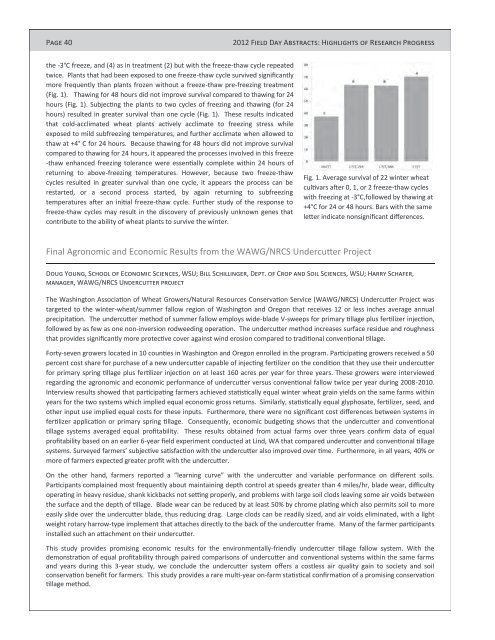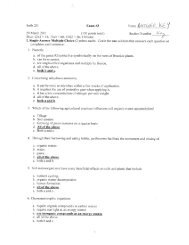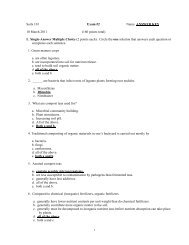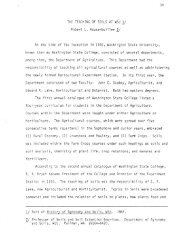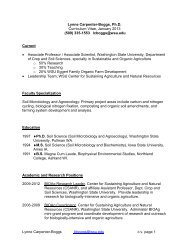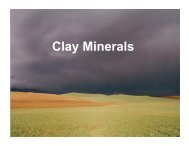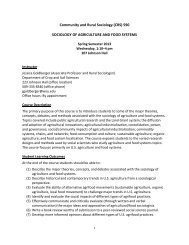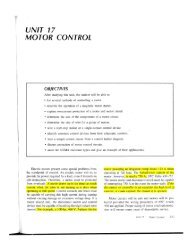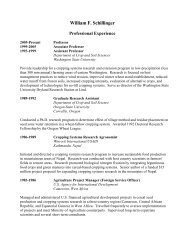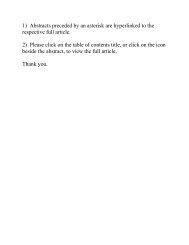2012 Dryland Field Day Abstracts - Dept. of Crop and Soil Sciences ...
2012 Dryland Field Day Abstracts - Dept. of Crop and Soil Sciences ...
2012 Dryland Field Day Abstracts - Dept. of Crop and Soil Sciences ...
Create successful ePaper yourself
Turn your PDF publications into a flip-book with our unique Google optimized e-Paper software.
Page 40<br />
the -3°C freeze, <strong>and</strong> (4) as in treatment (2) but with the freeze-thaw cycle repeated<br />
twice. Plants that had been exposed to one freeze-thaw cycle survived significantly<br />
more frequently than plants frozen without a freeze-thaw pre-freezing treatment<br />
(Fig. 1). Thawing for 48 hours did not improve survival compared to thawing for 24<br />
hours (Fig. 1). Subjecting the plants to two cycles <strong>of</strong> freezing <strong>and</strong> thawing (for 24<br />
hours) resulted in greater survival than one cycle (Fig. 1). These results indicated<br />
that cold-acclimated wheat plants actively acclimate to freezing stress while<br />
exposed to mild subfreezing temperatures, <strong>and</strong> further acclimate when allowed to<br />
thaw at +4° C for 24 hours. Because thawing for 48 hours did not improve survival<br />
compared to thawing for 24 hours, it appeared the processes involved in this freeze<br />
-thaw enhanced freezing tolerance were essentially complete within 24 hours <strong>of</strong><br />
returning to above-freezing temperatures. However, because two freeze-thaw<br />
cycles resulted in greater survival than one cycle, it appears the process can be<br />
restarted, or a second process started, by again returning to subfreezing<br />
temperatures after an initial freeze-thaw cycle. Further study <strong>of</strong> the response to<br />
freeze-thaw cycles may result in the discovery <strong>of</strong> previously unknown genes that<br />
contribute to the ability <strong>of</strong> wheat plants to survive the winter.<br />
<strong>2012</strong> <strong>Field</strong> <strong>Day</strong> <strong>Abstracts</strong>: Highlights <strong>of</strong> Research Progress<br />
Fig. 1. Average survival <strong>of</strong> 22 winter wheat<br />
cultivars after 0, 1, or 2 freeze-thaw cycles<br />
with freezing at -3°C,followed by thawing at<br />
+4°C for 24 or 48 hours. Bars with the same<br />
letter indicate nonsignificant differences.<br />
Final Agronomic <strong>and</strong> Economic Results from the WAWG/NRCS Undercutter Project<br />
Doug Young, School <strong>of</strong> Economic <strong>Sciences</strong>, WSU; Bill Schillinger, <strong>Dept</strong>. <strong>of</strong> <strong>Crop</strong> <strong>and</strong> <strong>Soil</strong> <strong>Sciences</strong>, WSU; Harry Schafer,<br />
manager, WAWG/NRCS Undercutter project<br />
The Washington Association <strong>of</strong> Wheat Growers/Natural Resources Conservation Service (WAWG/NRCS) Undercutter Project was<br />
targeted to the winter-wheat/summer fallow region <strong>of</strong> Washington <strong>and</strong> Oregon that receives 12 or less inches average annual<br />
precipitation. The undercutter method <strong>of</strong> summer fallow employs wide-blade V-sweeps for primary tillage plus fertilizer injection,<br />
followed by as few as one non-inversion rodweeding operation. The undercutter method increases surface residue <strong>and</strong> roughness<br />
that provides significantly more protective cover against wind erosion compared to traditional conventional tillage.<br />
Forty-seven growers located in 10 counties in Washington <strong>and</strong> Oregon enrolled in the program. Participating growers received a 50<br />
percent cost share for purchase <strong>of</strong> a new undercutter capable <strong>of</strong> injecting fertilizer on the condition that they use their undercutter<br />
for primary spring tillage plus fertilizer injection on at least 160 acres per year for three years. These growers were interviewed<br />
regarding the agronomic <strong>and</strong> economic performance <strong>of</strong> undercutter versus conventional fallow twice per year during 2008-2010.<br />
Interview results showed that participating farmers achieved statistically equal winter wheat grain yields on the same farms within<br />
years for the two systems which implied equal economic gross returns. Similarly, statistically equal glyphosate, fertilizer, seed, <strong>and</strong><br />
other input use implied equal costs for these inputs. Furthermore, there were no significant cost differences between systems in<br />
fertilizer application or primary spring tillage. Consequently, economic budgeting shows that the undercutter <strong>and</strong> conventional<br />
tillage systems averaged equal pr<strong>of</strong>itability. These results obtained from actual farms over three years confirm data <strong>of</strong> equal<br />
pr<strong>of</strong>itability based on an earlier 6-year field experiment conducted at Lind, WA that compared undercutter <strong>and</strong> conventional tillage<br />
systems. Surveyed farmers’ subjective satisfaction with the undercutter also improved over time. Furthermore, in all years, 40% or<br />
more <strong>of</strong> farmers expected greater pr<strong>of</strong>it with the undercutter.<br />
On the other h<strong>and</strong>, farmers reported a “learning curve” with the undercutter <strong>and</strong> variable performance on different soils.<br />
Participants complained most frequently about maintaining depth control at speeds greater than 4 miles/hr, blade wear, difficulty<br />
operating in heavy residue, shank kickbacks not setting properly, <strong>and</strong> problems with large soil clods leaving some air voids between<br />
the surface <strong>and</strong> the depth <strong>of</strong> tillage. Blade wear can be reduced by at least 50% by chrome plating which also permits soil to more<br />
easily slide over the undercutter blade, thus reducing drag. Large clods can be readily sized, <strong>and</strong> air voids eliminated, with a light<br />
weight rotary harrow-type implement that attaches directly to the back <strong>of</strong> the undercutter frame. Many <strong>of</strong> the farmer participants<br />
installed such an attachment on their undercutter.<br />
This study provides promising economic results for the environmentally-friendly undercutter tillage fallow system. With the<br />
demonstration <strong>of</strong> equal pr<strong>of</strong>itability through paired comparisons <strong>of</strong> undercutter <strong>and</strong> conventional systems within the same farms<br />
<strong>and</strong> years during this 3-year study, we conclude the undercutter system <strong>of</strong>fers a costless air quality gain to society <strong>and</strong> soil<br />
conservation benefit for farmers. This study provides a rare multi-year on-farm statistical confirmation <strong>of</strong> a promising conservation<br />
tillage method.


